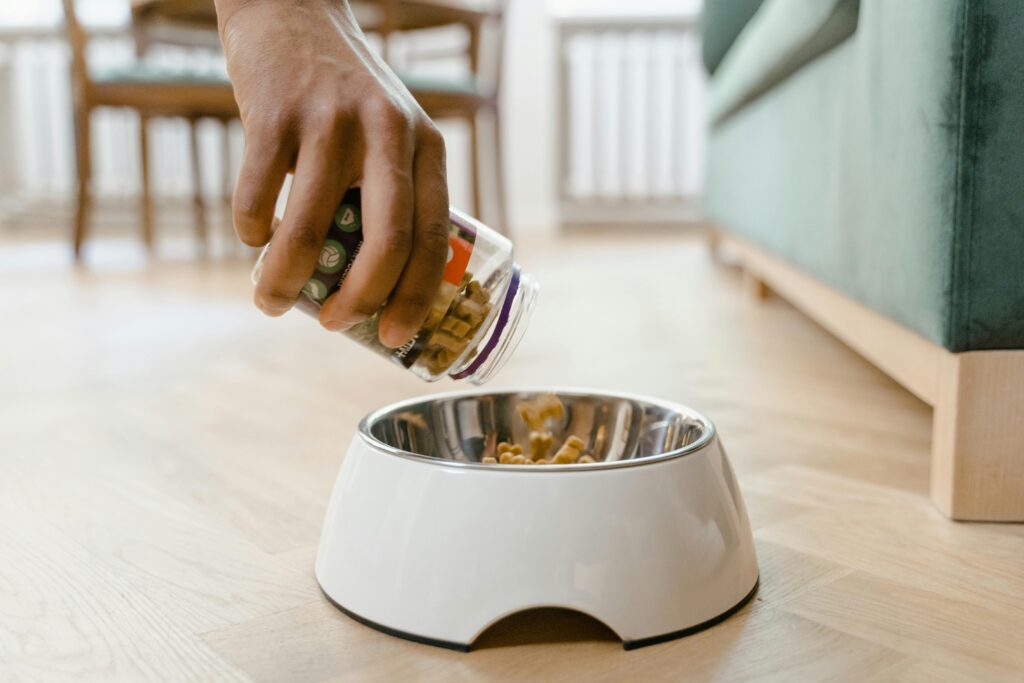Best Fresh Dog Food for Puppies: Your Expert Guide to Optimal Puppy Nutrition in 2025

Table of contents
- Understanding Why Best Fresh Dog Food for Puppies Represents Superior Puppy Nutrition
- Essential Puppy Nutrition Requirements: What Science Tells Us
- Comprehensive Review of the Best Fresh Dog Food for Puppies in 2025
- Strategic Approach to Transitioning Your Puppy to Fresh Dog Food
- Comprehensive Fresh Dog Food Feeding Guidelines for Puppies
- Essential Best Fresh Dog Food for Puppies Safety and Storage Protocols
- Cost-Benefit Analysis: Investing in Your Puppy’s Nutritional Future
- Advanced Considerations for Different Puppy Types
- Monitoring Your Puppy’s Response to Fresh Food
- Building Lifelong Healthy Eating Habits
- Making the Optimal Choice for Your Puppy’s Nutritional Future
Welcoming a new puppy into your family brings immense joy and equally important responsibilities. Among the most critical decisions you’ll make as a devoted pet parent is choosing the best fresh dog food for puppies to support their rapid growth and development.
Your puppy’s nutritional foundation during these crucial early months determines their lifelong health, energy levels, and overall wellbeing. This decision extends far beyond simply filling their food bowl.
Fresh dog food has transformed modern puppy nutrition by providing whole, minimally processed ingredients that deliver superior nutritional value compared to traditional kibble. Understanding how to select and properly feed the best fresh dog food for puppies empowers you to give your furry companion the optimal start they deserve.
This expert guide will walk you through the essential science of puppy nutrition, evaluate the top fresh food options available today, and provide practical strategies for successfully transitioning and maintaining your puppy’s fresh food diet.
Understanding Why Best Fresh Dog Food for Puppies Represents Superior Puppy Nutrition
The Scientific Foundation of Fresh Dog Food Benefits
Growing puppies require exceptional nutrition to support their remarkable development during the first year of life. Traditional kibble undergoes extensive high-heat processing that can significantly reduce the bioavailability of essential nutrients your developing puppy needs most.
Fresh dog food changes this nutritional equation by preserving the natural integrity of whole ingredients through gentle cooking methods. This preservation of nutrients means your puppy’s digestive system can more effectively absorb and utilize the proteins, vitamins, and minerals necessary for healthy growth.
The fresh pet food industry has experienced remarkable expansion, with the market growing by 28% annually as pet parents increasingly recognize the superior nutritional value of fresh ingredients. This growth reflects both scientific understanding and observable improvements in pet health outcomes.
Key Nutritional Advantages for Growing Puppies
Fresh dog food provides several critical advantages that directly support puppy development. The enhanced bioavailability of nutrients means your puppy’s body can access and use more of the essential building blocks needed for healthy growth. These whole food ingredients retain their natural enzyme content, which aids digestion and reduces the likelihood of gastrointestinal upset common in young puppies.
Additionally, fresh food eliminates artificial preservatives, synthetic colors, and unnecessary fillers that can interfere with optimal nutrient absorption. Many puppies also find fresh food more palatable than dry kibble, which encourages consistent eating habits during this crucial growth period.
The improved digestibility of fresh ingredients means your puppy expends less energy processing their food and can direct more energy toward growth, development, and playful activities that support their physical and mental development.
Unleash your puppy’s full potential: Dive into our comprehensive guide to puppy training 101 and build a foundation for a well-behaved dog.

Essential Puppy Nutrition Requirements: What Science Tells Us
AAFCO Standards and Federal Guidelines for Puppy Nutrition
The Association of American Feed Control Officials (AAFCO) establishes the nutritional standards that guide pet food formulation across the United States. According to AAFCO guidelines, puppy food must meet significantly higher nutritional requirements than adult dog food to support rapid growth and development.
AAFCO requires growing puppies to receive a minimum of 22.5% protein on a dry matter basis, with recommendations for 56.3 grams per 1,000 kcal ME for optimal growth support. This increased protein requirement compared to adult dogs reflects the intensive muscle development and organ growth occurring during puppyhood.
The FDA oversees pet food safety and works closely with AAFCO to ensure commercial pet foods meet established nutritional adequacy standards. Understanding how moisture content affects nutrient levels is crucial, as canned foods typically contain 75-78% moisture while dry foods contain 10-12% moisture, which affects the actual nutrient density your puppy receives.
Critical Nutrients for Healthy Puppy Development
Protein serves as the foundation of healthy puppy growth, providing essential amino acids for muscle development, immune system function, and cellular repair. Quality protein sources in fresh dog food typically include human-grade meats, fish, and poultry that provide complete amino acid profiles.
Fat content in puppy diets should range between 8-20% on a dry matter basis, providing concentrated energy for active growth while supplying essential fatty acids like DHA and EPA. These omega-3 fatty acids prove particularly important for brain development and cognitive function during the critical early months.
Calcium and phosphorus must be carefully balanced to support proper bone development without encouraging overly rapid growth that can lead to developmental orthopedic diseases, particularly in large breed puppies. The ideal calcium to phosphorus ratio should remain between 1.2:1 and 1.4:1.
Vitamins and minerals work synergistically to support immune system development, metabolic functions, and overall health. Fresh dog food naturally provides many of these micronutrients in their most bioavailable forms.
Comprehensive Review of the Best Fresh Dog Food for Puppies in 2025
The Farmer’s Dog: Premium Personalized Nutrition
The Farmer’s Dog consistently ranks as one of the best fresh dog food for puppies options available today, earning recognition for their commitment to human-grade ingredients and personalized nutrition plans. Their USDA-approved facilities ensure the highest safety standards while their gentle cooking methods preserve maximum nutritional value.
What sets The Farmer’s Dog apart for puppy nutrition is their customization approach. Each meal plan is formulated based on your puppy’s specific breed, current weight, expected adult size, and activity level. This personalization ensures your growing puppy receives precisely the right amount of calories and nutrients for optimal development.
Their turkey recipe provides lean, high-quality protein while sweet potatoes offer easily digestible carbohydrates that provide sustained energy for active puppies. The inclusion of carrots, spinach, and other vegetables adds essential vitamins and minerals in their natural forms.
The company’s subscription model delivers fresh meals directly to your door with appropriate portions pre-packaged for convenience. This eliminates guesswork in portion control while ensuring your puppy always has access to fresh, nutritious meals.
Nom Nom: Veterinarian-Formulated Excellence
Nom Nom distinguishes itself through its board-certified veterinary nutritionists who formulate every recipe to exceed AAFCO standards while maximizing nutritional quality. Their fresh dog food for puppies addresses the unique needs of growing dogs through carefully balanced recipes.
The Nom Nom Beef Mash provides high-quality protein from human-grade beef combined with brown rice for digestible carbohydrates. The addition of carrots, eggs, and spinach creates a nutritionally complete meal that supports healthy growth and development.
Their portion control system bases serving sizes on your puppy’s current weight, target adult weight, and activity level, with regular adjustments as your puppy grows. This dynamic approach ensures consistent, appropriate nutrition throughout the rapid growth phase.
Nom Nom’s commitment to food safety includes batch testing and strict quality control measures that provide peace of mind for pet parents concerned about food safety for their young puppies.
Transform your puppy into an obedient companion: Our comprehensive guide to mastering puppy obedience has everything you need.
Ollie: Fresh Ingredients with Scientific Backing
Ollie combines the appeal of fresh, whole ingredients with rigorous scientific formulation to create puppy fresh food that supports optimal development. Their recipes are developed by veterinary nutritionists and manufactured in USDA-approved facilities.
The Ollie Chicken Recipe features free-range chicken as the primary protein source, combined with sweet potatoes, carrots, and spinach. This combination provides complete amino acid profiles while delivering essential vitamins and minerals in their most natural forms.
What makes Ollie particularly suitable for puppies is their attention to digestibility. The gentle cooking process and whole food ingredients reduce the likelihood of digestive upset that can occur when transitioning young puppies to new foods.
Their packaging in individual portions helps maintain freshness while making feeding time convenient and precise. Each meal is labeled with feeding instructions specific to your puppy’s age and size.
Spot & Tango: Customized Fresh Nutrition
Spot & Tango offers highly customized fresh puppy food formulated specifically for your individual puppy’s needs. Their UnKibble Fresh recipe provides the nutritional benefits of fresh food in a convenient, shelf-stable format.
Their customization process considers your puppy’s breed, age, weight, activity level, and any food sensitivities to create a personalized meal plan. This individualized approach ensures your puppy receives optimal nutrition for their specific growth trajectory.
The company’s commitment to transparency includes detailed nutritional information for each recipe and regular communication about your puppy’s changing nutritional needs as they grow.
Got a Golden bundle of joy? Learn the secrets to nurturing your new companion with our expert Golden Retriever puppy training tips.

Strategic Approach to Transitioning Your Puppy to Fresh Dog Food
Best Fresh Dog Food for Puppies: The Science-Based Transition Protocol
Successfully transitioning your puppy to fresh dog food requires patience and systematic approach to prevent digestive upset. Young puppies have sensitive digestive systems that need time to adjust to new ingredients and textures.
The veterinarian-recommended transition schedule spans approximately four weeks, allowing your puppy’s digestive system to gradually adapt while maintaining nutritional consistency. This gradual approach minimizes the risk of gastrointestinal upset while ensuring your puppy continues to receive adequate nutrition throughout the transition.
Week One Implementation: Begin with 25% fresh food mixed with 75% of your puppy’s current food. This ratio allows your puppy to experience new flavors while maintaining digestive stability. Monitor your puppy’s stool consistency, energy levels, and appetite during this initial phase.
Week Two Progression: Increase to 50% fresh food and 50% current food. At this midpoint, your puppy should show signs of adaptation including maintained energy levels and normal bowel movements. Continue monitoring for any signs of digestive distress.
Week Three Advancement: Move to 75% fresh food and 25% current food. Your puppy should now be consuming primarily fresh food with minimal digestive adjustment needed.
Week Four Completion: Transition to 100% fresh food. Your puppy should now be fully adapted to their new fresh food diet with improved energy, coat quality, and overall health markers.
Best Fresh Dog Food for Puppies: Recognizing Successful Transition Indicators
Monitor your puppy for positive health indicators that confirm successful adaptation to fresh food. Improved coat shine and softness often appear within the first two weeks as better nutrition supports healthy skin and fur development.
Energy levels should remain consistent or improve as your puppy’s body more efficiently processes the higher-quality nutrients. Many pet parents notice increased playfulness and alertness as their puppy’s nutrition improves.
Digestive health improvements include smaller, firmer stools with less odor, indicating better nutrient absorption and digestive efficiency. Breath quality often improves as well, reflecting better overall digestive health.
Comprehensive Fresh Dog Food Feeding Guidelines for Puppies
Best Fresh Dog Food for Puppies: Age-Specific Feeding Protocols
Early Puppyhood (8-12 Weeks): Young puppies require four meals daily, spaced evenly throughout the day to maintain stable blood sugar levels and support rapid growth. Their small stomach capacity necessitates frequent, smaller meals rather than fewer large meals.
The timing of meals should align with your puppy’s natural energy patterns, typically including breakfast, lunch, dinner, and a small evening meal. This schedule also supports house training by creating predictable elimination patterns.
Mid Puppyhood (12-20 Weeks): Most puppies can transition to three meals daily during this period. Morning, midday, and evening meals provide adequate nutrition while allowing for longer intervals between feedings.
This reduction in meal frequency should be gradual, with portion sizes adjusted to ensure your puppy continues receiving appropriate daily nutrition. Monitor your puppy’s energy levels and growth rate during this transition period.
Late Puppyhood (20 Weeks to 1 Year): Many puppies can successfully transition to twice-daily feeding, though some larger breeds benefit from continued three-meal schedules to support their extended growth periods.
The decision to reduce meal frequency should be based on your individual puppy’s needs, growth rate, and preferences rather than strictly following age guidelines.
Best Fresh Dog Food for Puppies: Precision in Portion Control
Accurate portion control prevents both malnutrition and overfeeding, both of which can significantly impact your puppy’s development. Fresh food companies typically provide feeding guidelines based on your puppy’s current weight and expected adult size, but these serve as starting points rather than absolute requirements.
Small Breed Considerations: Puppies expected to weigh less than 25 pounds as adults generally require more calories per pound of body weight due to their higher metabolic rates and faster growth completion.
Medium Breed Guidelines: Puppies expected to weigh 25-60 pounds as adults typically follow standard feeding guidelines with adjustments based on individual activity levels and growth rates.
Large Breed Protocols: Puppies expected to exceed 60 pounds as adults require careful portion control to prevent overly rapid growth that can lead to developmental orthopedic diseases. Controlled growth is healthier than maximum growth for these breeds.
Help your puppy make friends (and build confidence!): Explore our guide on socializing your puppy for a happy, well-adjusted dog.
Essential Best Fresh Dog Food for Puppies Safety and Storage Protocols
Professional Food Safety Standards
Fresh dog food requires the same careful handling as human food to maintain safety and nutritional quality. Understanding proper storage techniques protects your puppy from foodborne illness while preserving the nutritional integrity of their meals.
Refrigeration Requirements: Store unopened fresh dog food packages in the refrigerator at temperatures below 40°F for no more than 7 days from delivery. Once opened, use within 3-4 days to ensure optimal freshness and safety.
Freezer Storage Protocols: Most fresh dog foods can be safely frozen for up to 6 months without significant nutritional loss. Freeze meals in daily or weekly portions for convenient thawing and portion control.
Thawing Best Practices: Always thaw frozen fresh dog food overnight in the refrigerator, never at room temperature. This gradual thawing maintains food safety while preserving texture and nutritional quality.
Daily Handling and Serving Guidelines
Temperature Control: Serve fresh dog food at room temperature or slightly warmed to enhance palatability. Never serve food that has been sitting at room temperature for more than 2 hours, or 1 hour in temperatures above 90°F.
Cleanliness Protocols: Wash your hands thoroughly before and after handling fresh dog food. Use clean bowls and utensils for each meal, and wash food bowls with hot, soapy water after each feeding.
Portion Hygiene: Only remove the amount of food needed for each meal from the refrigerator. Return unused portions immediately to maintain proper temperature control.

Cost-Benefit Analysis: Investing in Your Puppy’s Nutritional Future
Understanding the Financial Investment
Fresh dog food typically costs more per pound than traditional kibble, with monthly expenses ranging from $50-150 depending on your puppy’s size and the specific brand chosen. However, this cost should be evaluated within the context of your puppy’s overall health and long-term veterinary expenses.
Budget Planning Strategies: Calculate monthly fresh food costs before committing to ensure the expense fits comfortably within your pet care budget. Many companies offer introductory discounts or flexible subscription options that can help manage costs.
Hybrid Feeding Approaches: Some pet parents successfully combine high-quality fresh food with premium kibble to balance nutritional benefits with budget constraints. This approach can provide many fresh food benefits while managing costs.
Long-Term Value Considerations
The investment in superior nutrition during puppyhood often yields significant returns in terms of your dog’s lifelong health. Better nutrition supports stronger immune systems, which can reduce veterinary expenses related to preventable health issues.
High-quality nutrition during the growth phase supports proper development, potentially preventing expensive orthopedic issues that can arise from poor nutrition during critical development periods. The enhanced digestibility of fresh food may also reduce gastrointestinal issues that require veterinary intervention.
Advanced Considerations for Different Puppy Types
Small Breed Puppy Nutrition Specifics
Small breed puppies face unique nutritional challenges due to their rapid growth completion and high metabolic rates. These puppies typically reach adult size by 9-12 months and require calorie-dense nutrition to prevent hypoglycemia and support their accelerated development.
Energy Density Requirements: Small breed puppies need approximately 50% more calories per pound of body weight compared to large breed puppies. The best fresh dog food for puppies of small breeds should provide concentrated nutrition in smaller serving sizes.
Texture Considerations: Small puppies may benefit from finely chopped or minced fresh food that’s easier to chew and digest. Some fresh food companies offer small-breed specific formulations with appropriate texture modifications.
Large Breed Puppy Growth Management
Large breed puppies require careful nutritional management to support healthy development while preventing rapid growth that can lead to developmental orthopedic diseases. These puppies benefit from controlled calorie intake and specific calcium-phosphorus ratios.
Growth Rate Control: The goal for large breed puppies is steady, controlled growth rather than maximum growth rate. Fresh puppy food for large breeds should provide adequate nutrition without excessive calories that promote rapid weight gain.
Calcium-Phosphorus Balance: Large breed puppies require precise calcium and phosphorus ratios to support proper bone development. Excessive calcium can interfere with proper skeletal development, while insufficient calcium can cause developmental problems.
The World Small Animal Veterinary Association (WSAVA) nutrition guidelines provide detailed recommendations for large breed puppy nutrition that emphasize controlled growth rates and balanced mineral content.
Want a well-behaved puppy, fast? Discover 7 proven tips for rapid puppy training results that really work!
Monitoring Your Puppy’s Response to Fresh Food
Health Improvement Indicators
Physical Development Markers: Watch for improved coat quality, which often appears within 2-3 weeks of transitioning to fresh food. The coat should become shinier, softer, and more vibrant as better nutrition supports healthy skin and fur development.
Energy levels should remain consistent or improve as your puppy’s body more efficiently processes high-quality nutrients. Many pet parents notice increased playfulness, better focus during training sessions, and more consistent sleep patterns.
Digestive Health Improvements: Successful fresh food adaptation typically results in smaller, firmer stools with reduced odor. This change indicates improved nutrient absorption and better digestive efficiency.
Breath quality often improves as well, reflecting overall better digestive health and reduced bacterial overgrowth that can occur with lower-quality diets.
When to Consult Your Veterinarian
Contact your veterinarian if you observe persistent digestive upset beyond the normal transition period, including diarrhea lasting more than 48 hours, vomiting, or loss of appetite extending beyond 24 hours.
Changes in energy levels, including unusual lethargy or hyperactivity, warrant veterinary evaluation to ensure your puppy’s nutritional needs are being met appropriately.
Regular veterinary check-ups during puppyhood allow for growth monitoring and nutritional assessment to ensure your fresh food program supports optimal development.
Building Lifelong Healthy Eating Habits
Establishing Positive Mealtime Routines
Consistent feeding schedules help your puppy develop healthy eating habits while supporting successful house training. Regular meal times create predictable elimination schedules and reduce anxiety around food availability.
Routine Benefits: Predictable feeding times help regulate your puppy’s internal clock, supporting better sleep patterns and more consistent energy levels throughout the day. This regularity also facilitates training by creating natural reward opportunities.
Environmental Considerations: Create a calm, quiet feeding environment that allows your puppy to focus on eating without distractions. This peaceful atmosphere helps prevent food guarding behaviors and supports proper digestion.
Preventing Food-Related Behavioral Issues
Positive Associations: Make mealtime a positive experience by remaining calm and patient during feeding. Avoid rushing your puppy or creating pressure around eating, which can lead to food anxiety or aggressive behaviors.
Portion Control Education: Teaching your puppy to eat appropriate portions helps prevent overeating and supports healthy weight management throughout their life. This education begins with consistent portion sizes and regular meal schedules.
Most healthy puppies thrive on fresh food diets, but individual factors should be considered. Consult with your veterinarian to evaluate your puppy’s specific health status, growth trajectory, and any breed-specific nutritional considerations. Some puppies with certain health conditions may require specialized diets that fresh food companies can accommodate through customization options. Signs that fresh food works well include consistent energy levels, healthy coat quality, normal digestive function, and appropriate growth rates for your puppy’s breed and age.
Yes, many pet parents successfully implement hybrid feeding approaches that combine fresh food with premium kibble. This strategy can provide nutritional benefits while managing budget constraints. Start with a 75% kibble and 25% fresh food ratio, then adjust based on your puppy’s response and your budget. Ensure both foods meet AAFCO standards for complete nutrition, and maintain consistent meal times regardless of the food combination. Monitor your puppy’s digestive response and overall health when implementing any feeding changes.
Fresh dog food costs vary significantly based on your puppy’s size, age, and the specific brand chosen. Small breed puppies typically cost $50-80 monthly, while large breed puppies may cost $100-150 monthly. These costs often decrease as your puppy transitions to adult portions and feeding schedules. Consider this investment in the context of your puppy’s long-term health, as superior nutrition during growth phases can prevent expensive health issues later in life. Many companies offer subscription discounts and introductory offers that can help manage initial costs.
Some puppies need time to adjust to new textures and flavors, particularly if they’ve been eating kibble exclusively. Try warming the fresh food slightly to enhance its aroma, which can increase palatability. Mixing a small amount of low-sodium bone broth or adding a sprinkle of their current favorite treats can encourage initial acceptance. Ensure you’re offering appropriately sized portions, as puppies can be overwhelmed by large amounts of new food. If your puppy refuses food for more than 24 hours, consult your veterinarian to rule out underlying health issues.
Fresh dog food requires careful handling similar to human food. Store unopened packages in the refrigerator at temperatures below 40°F for no more than 7 days from delivery. Once opened, use within 3-4 days for optimal safety and freshness. For longer storage, freeze portions for up to 6 months, then thaw overnight in the refrigerator before serving. Never leave fresh food at room temperature for more than 2 hours, or 1 hour in temperatures above 90°F. Use clean utensils when serving and wash food bowls thoroughly after each meal.
Fresh food is generally safe for puppies 8 weeks and older who have been successfully weaned from their mother’s milk. However, very young puppies may need food with modified textures that are easier to chew and digest. Some fresh food companies offer puppy-specific formulations with appropriate texture modifications for young puppies. The transition from puppy milk replacer or mother’s milk to fresh food should be gradual, potentially requiring additional texture modifications initially. Consult with your veterinarian for guidance on appropriate foods for very young puppies.
Fresh food can be beneficial for puppies with food sensitivities because it typically contains fewer ingredients and no artificial additives that can trigger reactions. The limited ingredient lists make it easier to identify and avoid problematic ingredients through elimination diets. However, puppies can still develop allergies to natural ingredients like specific proteins or grains. Work with your veterinarian to identify specific allergens through systematic elimination and reintroduction protocols. Some fresh food companies offer limited ingredient recipes specifically designed for dogs with food sensitivities.
Fresh dog food uses minimally processed, whole ingredients that are gently cooked to preserve maximum nutritional value. This differs from freeze-dried food, which removes moisture while preserving nutrients but may have different palatability characteristics. Traditional kibble undergoes high-heat processing that can reduce nutritional bioavailability, though premium kibbles may use higher-quality ingredients. Raw food diets provide completely unprocessed ingredients but require careful handling to prevent bacterial contamination. Fresh food typically offers the best balance of nutritional quality, safety, and convenience for most pet parents.
Transitioning between fresh food brands follows the same gradual process used when switching from kibble to fresh food. Begin with 25% new food mixed with 75% current food for several days, then gradually increase the new food percentage over 7-10 days. This prevents digestive upset while allowing your puppy to adjust to new flavors and ingredient profiles. Monitor your puppy’s stool consistency, energy levels, and appetite throughout the transition. Some puppies benefit from even more gradual transitions, particularly if they have sensitive digestive systems.
The transition timing varies by breed size and individual development. Small breed puppies typically transition to adult formulations at 9-12 months when they reach adult size. Medium breeds usually transition at 12-15 months, while large and giant breeds may continue on puppy formulations until 18-24 months due to their extended growth periods. The decision should be based on your puppy reaching approximately 90% of their expected adult weight rather than strictly following age guidelines. Consult with your veterinarian to determine the optimal transition timing for your specific puppy, as individual growth rates can vary significantly even within breeds.
Making the Optimal Choice for Your Puppy’s Nutritional Future
Selecting the best fresh dog food for puppies represents one of the most impactful decisions you’ll make for your new family member’s lifelong health and wellbeing. The superior nutritional quality of fresh food provides the foundation for optimal growth, development, and immune system function during these critical early months.
Remember that every puppy is unique, with individual nutritional needs influenced by breed characteristics, growth patterns, activity levels, and health status. What proves perfect for one puppy may require adjustments for another, emphasizing the importance of monitoring your puppy’s response and working closely with your veterinarian throughout their development.
The investment in high-quality fresh dog food during puppyhood extends far beyond the immediate costs. Superior nutrition during the growth phase supports stronger immune systems, proper skeletal development, optimal brain function, and healthy organ development that benefits your dog throughout their entire life.
Your puppy’s dependence on your nutritional choices creates both responsibility and opportunity. By choosing quality fresh food, establishing healthy feeding routines, and monitoring their developmental response, you’re creating the foundation for a lifetime of health, energy, and happiness together.
The time you invest now in understanding your puppy’s nutritional needs and implementing appropriate fresh food feeding protocols will reward both of you with years of vibrant health and joyful companionship. Your commitment to excellence in puppy nutrition demonstrates your dedication to providing the best possible start for your beloved companion’s life journey.
Medical Disclaimer: This comprehensive guide provides educational information only and should never replace professional veterinary advice. Always consult with a licensed veterinarian before making significant changes to your puppy’s nutrition plan or if you have concerns about your puppy’s health and development.







